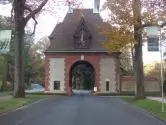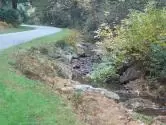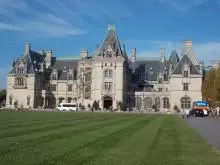A Walk with Frederick Law Olmsted

One of the most critical components of directing a successful Arts and Crafts Conference is knowing what people want.
And it’s really quite easy.
Just ask.
A few years ago people answered, suggesting something different on Saturday evening, yet still educational. We tested the waters with what was then the new PBS documentary on Elbert Hubbard and found out people enjoyed a Saturday night movie. We have since shown documentaries on the photographer George Masa and the naturalist John Muir, and announced last summer that in February we would offer a PBS documentary on American’s first landscape architect Frederick Law Olmsted.
While Olmsted is best known for Manhattan’s Central Park, he actually wrapped up his lengthy career with what he called his finest work and easiest client: George Vanderbilt’s winter home he named the Biltmore Estate.
Since the 250-room Biltmore House and what originally was the 125,000-acre estate sits just south of Asheville, I decided that I would prepare a twenty-minute warm-up to the movie by taking our audience on a Power-Point journey to the Biltmore Estate. Like most locals, I had toured the Biltmore House several years ago, but had not been back since then. Last week I suddenly realized that if I did not get out there quickly, Frederick Law Olmsted’s landscape plan would be looking rather leafless and barren.

And so on a bright, beautiful Tuesday morning I was among the first to drive through the gates (top) and up the three-mile Approach Road (middle) leading to the Biltmore House (bottom). But whereas the others streaming in along with me were anxious to get to the mansion, I kept pulling over and taking pictures. Once parked and walking on the front lawn, I discovered to my delight that everyone else was headed to the front doors, leaving me virtually alone with Frederick Law Olmsted’s carefully designed grounds.
Of course, having just read Pamela Lynn Messer’s book Biltmore Estate: Frederick Law Olmsted’s Landscape Masterpiece, on this visit I knew what to look for and understood better the meticulous progression of gardens on the descending slope: from the formal Italian Gardens next to the house on the bluff down through the Walled Garden, the Azalea Gardens, the Bass Pond, the Meadow, and the Woods to the sustaining crops planted on the bottomland next to the French Broad River.
It was a delightful little journey, one that made me feel like I was on vacation, snapping pictures and watching the gardeners trimming back the shrubs and dead-heading the wilted summer flowers. I ended my morning by treating myself to lunch on the open courtyard between the house and Vanderbilt’s stables, now a row of shops, bookstores, and cafes.
And I marveled at how efficiently the grandson (William Cecil, now 86) and two great-grandchildren of George and Edith Vanderbilt, and their staffs manage the estate and its nearly one million visitors a year, all of whom were, like me, enjoying their day wandering about the grounds and appreciating the work of Frederick Law Olmsted.

Until next Monday,
Take your own mini-vacation!
Bruce
And if you’re intrigued about taking an Arts and Crafts vacation at the Grove Park Inn for the National Arts and Crafts Conference on February 20-22, click here to print out your own brochure-agenda:
http://www.arts-craftsconference.com/images/Brochure.2015.pdf
Top: The first entrance to the estate.
Middle: The Approach Road following the winding contour of this stream.
Bottom: It may not be an Arts and Crafts bungalow, but its all fine craftsmanship.
